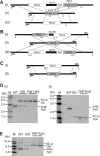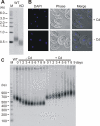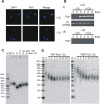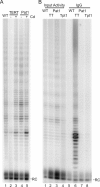The Pot1a-associated proteins Tpt1 and Pat1 coordinate telomere protection and length regulation in Tetrahymena
- PMID: 21900503
- PMCID: PMC3204076
- DOI: 10.1091/mbc.E11-06-0551
The Pot1a-associated proteins Tpt1 and Pat1 coordinate telomere protection and length regulation in Tetrahymena
Abstract
We have identified two new telomere proteins, Tpt1 and Pat1, from the ciliate Tetrahymena thermophila. Although Tetrahymena telomerase is well characterized, only one telomere protein had previously been identified. This was the G-overhang binding-protein Pot1a. Tpt1 and Pat1 were isolated as Pot1a binding partners and shown to localize to telomeres. As Tpt1 and Pat1 were both found to be essential, conditional cell lines were generated to explore their function. Tpt1 depletion caused a rapid growth arrest and telomere elongation in the absence of cell division. The phenotype was similar to that seen after Pot1a depletion suggesting that Tpt1 and Pot1a function together to regulate telomere length and prevent telomere deprotection. In contrast, Pat1 depletion had a modest effect on cell growth but caused progressive telomere shortening similar to that observed upon TERT depletion. Thus Pat1 appears to be needed for telomerase to maintain the chromosome terminus. Analysis of Pot1a-Tpt1-Pat1 complex formation using purified proteins indicated that Tpt1 interacts directly with Pot1a while Pat1 interacts with Tpt1. Our results indicate that Tpt1 is the Tetrahymena equivalent of mammalian TPP1, Schizosaccharomyces pombe Tpz1, and Oxytricha nova TEBPβ.
Figures







Similar articles
-
The 3' overhangs at Tetrahymena thermophila telomeres are packaged by four proteins, Pot1a, Tpt1, Pat1, and Pat2.Eukaryot Cell. 2014 Feb;13(2):240-5. doi: 10.1128/EC.00275-13. Epub 2013 Dec 2. Eukaryot Cell. 2014. PMID: 24297442 Free PMC article.
-
Tetrahymena POT1a regulates telomere length and prevents activation of a cell cycle checkpoint.Mol Cell Biol. 2007 Mar;27(5):1592-601. doi: 10.1128/MCB.01975-06. Epub 2006 Dec 11. Mol Cell Biol. 2007. PMID: 17158924 Free PMC article.
-
Tetrahymena Pot2 is a developmentally regulated paralog of Pot1 that localizes to chromosome breakage sites but not to telomeres.Eukaryot Cell. 2014 Dec;13(12):1519-29. doi: 10.1128/EC.00204-14. Epub 2014 Oct 10. Eukaryot Cell. 2014. PMID: 25303953 Free PMC article.
-
The telomere and telomerase: nucleic acid-protein complexes acting in a telomere homeostasis system. A review.Biochemistry (Mosc). 1997 Nov;62(11):1196-201. Biochemistry (Mosc). 1997. PMID: 9467842 Review.
-
Telomerase Mechanism of Telomere Synthesis.Annu Rev Biochem. 2017 Jun 20;86:439-460. doi: 10.1146/annurev-biochem-061516-045019. Epub 2017 Jan 30. Annu Rev Biochem. 2017. PMID: 28141967 Free PMC article. Review.
Cited by
-
A popular engagement at the ends.Nat Struct Mol Biol. 2013 Jan;20(1):10-2. doi: 10.1038/nsmb.2483. Nat Struct Mol Biol. 2013. PMID: 23288360 Free PMC article.
-
Current Perspectives of Telomerase Structure and Function in Eukaryotes with Emerging Views on Telomerase in Human Parasites.Int J Mol Sci. 2018 Jan 24;19(2):333. doi: 10.3390/ijms19020333. Int J Mol Sci. 2018. PMID: 29364142 Free PMC article. Review.
-
Direct single-stranded DNA binding by Teb1 mediates the recruitment of Tetrahymena thermophila telomerase to telomeres.Mol Cell Biol. 2014 Nov 15;34(22):4200-12. doi: 10.1128/MCB.01030-14. Epub 2014 Sep 15. Mol Cell Biol. 2014. PMID: 25225329 Free PMC article.
-
The Oxytricha trifallax macronuclear genome: a complex eukaryotic genome with 16,000 tiny chromosomes.PLoS Biol. 2013;11(1):e1001473. doi: 10.1371/journal.pbio.1001473. Epub 2013 Jan 29. PLoS Biol. 2013. PMID: 23382650 Free PMC article.
-
The 3' overhangs at Tetrahymena thermophila telomeres are packaged by four proteins, Pot1a, Tpt1, Pat1, and Pat2.Eukaryot Cell. 2014 Feb;13(2):240-5. doi: 10.1128/EC.00275-13. Epub 2013 Dec 2. Eukaryot Cell. 2014. PMID: 24297442 Free PMC article.
References
-
- Cohen P, Blackburn EH. Two types of telomeric chromatin in Tetrahymena thermophila. J Mol Biol. 1998;280:327–344. - PubMed
Publication types
MeSH terms
Substances
Grants and funding
LinkOut - more resources
Full Text Sources
Research Materials

